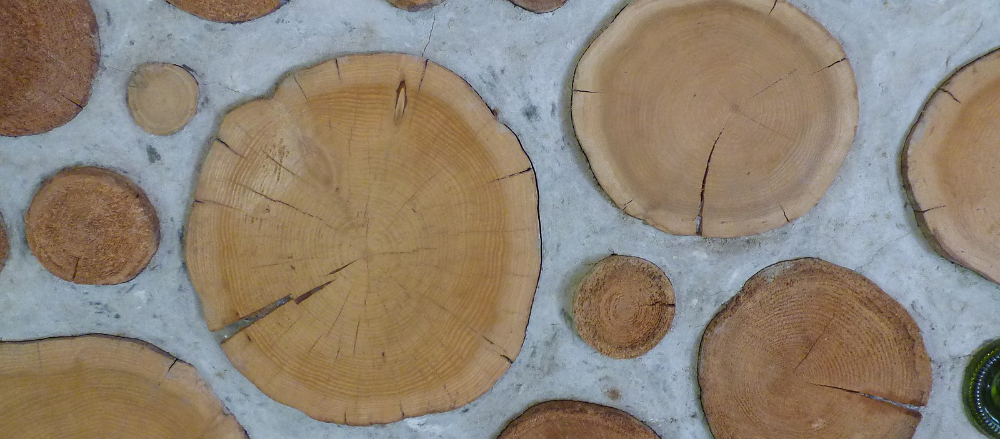Cordwood
Cordwood is a term used to describe a pile of wood that is cut into lengths of a similar size and stacked in a single row. The term can describe wood that has been stacked as a storage method for firewood, but it can also be used to describe a stack of wood used to construct a wall, often with lime mortar in between and sometimes referred to as a stackwall.
In the US, more specifically, a full cord of wood is a stack of timber firewood lengths that is 4 feet tall, 8 feet long, and 4 feet deep (1.2 by 2.4 by 1.2 metres deep). Face chord describes the same surface area of a wood stack but where the depth of the wood is only 16 inches, about a third of a full chord or less than half a metre in depth.
Cordwood construction is a construction method that uses end-grain logs of varying lengths stacked to form walls, usually with mortar in between. In his book Essential Cordwood Building: The complete step-by-step guide (New Society Publishers, 2018; Gabriola Island, Canada), Rob Roy suggests a common mix by volume to be sand (9 parts), sawdust, and non-agricultural lime (3 parts each) with Portland cement (2 parts). As the timbers are end grain, they are likely to dry and move. The suggested mix takes some time to cure, allowing for some movement.
The origins of cordwood are unclear, but structures around 1000 years old existing in Germany and other countries such as Sweden and Canada also have some tradition of employing this method. It has some advantages because it can make effective use of off-cuts and end logs, not requiring the longer timbers usually needed for framing and log construction. It is also a relatively simple and cost-effective vernacular construction method, making it popular with self-builders, and as walls often contain high quantities of mortar, it has increased thermal as well as some insulative properties. As the timbers are laid with the end grain exposed externally, the thermal properties are decreased, though this can be countered by the depth of the timbers that are used, as well as the introduction of vermiculate into the mortar mix and the potential for cavity wall construction or two layers.
While it remains not a particularly common construction method, its use of potential waste end-grain wood material from logging makes it very cost-effective. It is still an approach that is used today in many different countries. The image above is described as; a built section of cordwood masonry wall. Cut log ends protrude slightly from the pointed mortar join. Earthwood Building School, 2016. (source: cordwoodmasonry.com Author Trajinus under CC license).
[edit] Related articles on Designing Buildings
- Cement mortar.
- Deforestation.
- Dry hydrate lime mortar.
- Forests.
- Grout.
- Hot-mixed lime mortar.
- Hemp lime construction: A guide to building with hemp lime composites.
- Hydraulic lime.
- Lime putty mortar.
- Lime run-off.
- Mortar.
- Mortar analysis for specifiers.
- Pointing.
- Portland cement.
- Sustainable timber.
- Sweet chestnut
- Timber species
- Types of rapidly renewable content
- The history of timber construction in the UK.
- Types of rapidly renewable content
- Types of mortar.
Featured articles and news
One of the most impressive Victorian architects. Book review.
Common Assessment Standard now with building safety
New CAS update now includes building safety questions as mandatory.
RTPI leader to become new CIOB Chief Executive Officer
Dr Victoria Hills MRTPI, FICE to take over after Caroline Gumble’s departure.
Social and affordable housing, a long term plan for delivery
The “Delivering a Decade of Renewal for Social and Affordable Housing” strategy sets out future path.
A change to adoptive architecture
Effects of global weather warming on architectural detailing, material choice and human interaction.
The proposed publicly owned and backed subsidiary of Homes England, to facilitate new homes.
How big is the problem and what can we do to mitigate the effects?
Overheating guidance and tools for building designers
A number of cool guides to help with the heat.
The UK's Modern Industrial Strategy: A 10 year plan
Previous consultation criticism, current key elements and general support with some persisting reservations.
Building Safety Regulator reforms
New roles, new staff and a new fast track service pave the way for a single construction regulator.
Architectural Technologist CPDs and Communications
CIAT CPD… and how you can do it!
Cooling centres and cool spaces
Managing extreme heat in cities by directing the public to places for heat stress relief and water sources.
Winter gardens: A brief history and warm variations
Extending the season with glass in different forms and terms.
Restoring Great Yarmouth's Winter Gardens
Transforming one of the least sustainable constructions imaginable.
Construction Skills Mission Board launch sector drive
Newly formed government and industry collaboration set strategy for recruiting an additional 100,000 construction workers a year.
New Architects Code comes into effect in September 2025
ARB Architects Code of Conduct and Practice available with ongoing consultation regarding guidance.
Welsh Skills Body (Medr) launches ambitious plan
The new skills body brings together funding and regulation of tertiary education and research for the devolved nation.
Paul Gandy FCIOB announced as next CIOB President
Former Tilbury Douglas CEO takes helm.
























